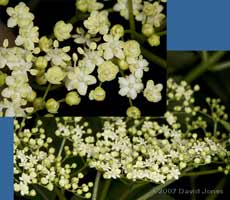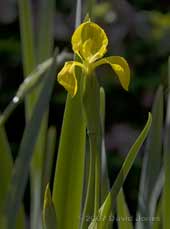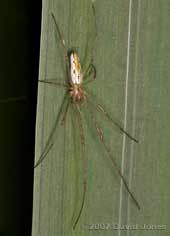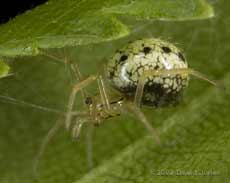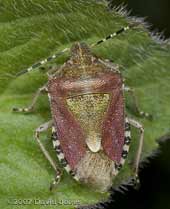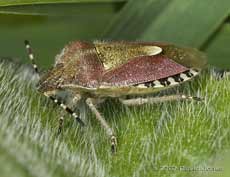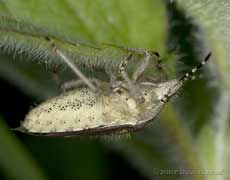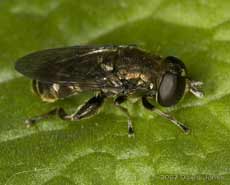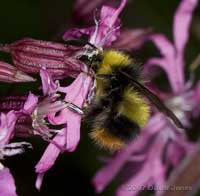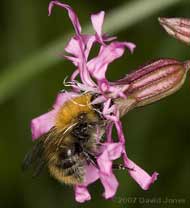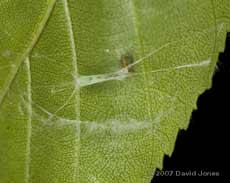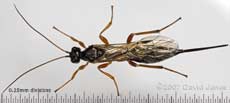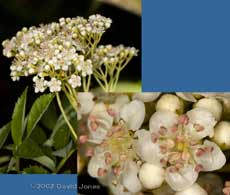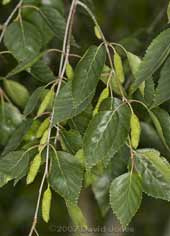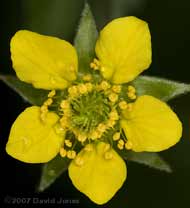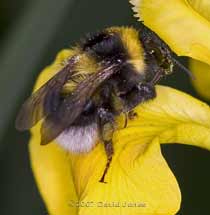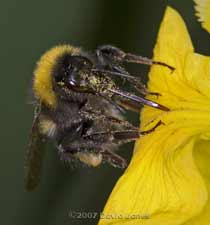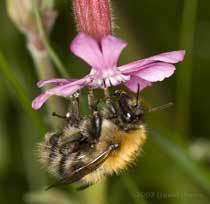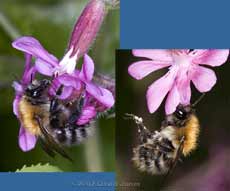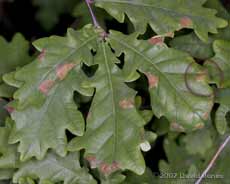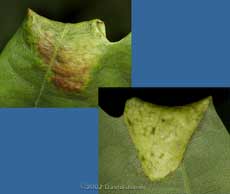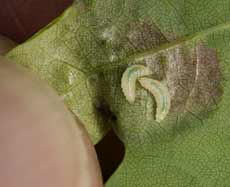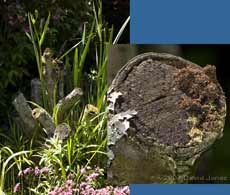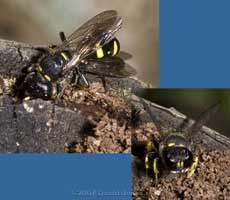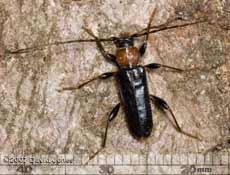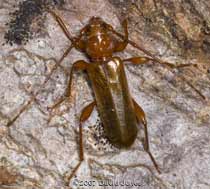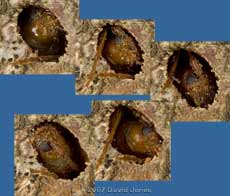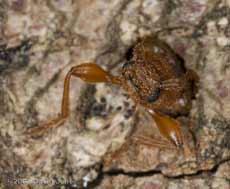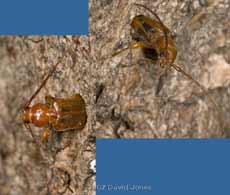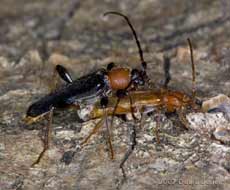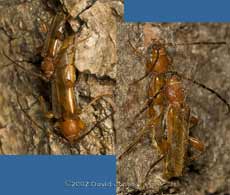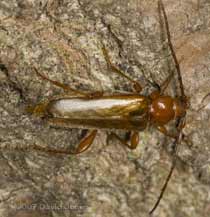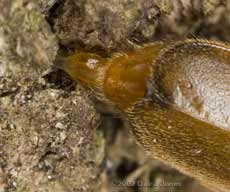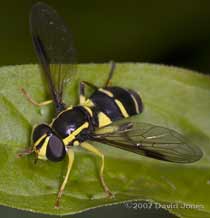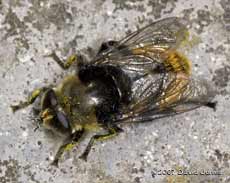Go to the last entry on this page .....Go to previous entry16 May - A brighter day with just a few spots of rain after a glum period, and the daytime temperatures are starting to creep up again. After a high of just 11C two days ago, yesterday it reached 15C and today nearly got to 16C!
A couple of flower reports to start with - the first Elder flowers opened yesterday,
and the first Flag Iris flower burst open this morning. I know that should be in the pond diary, but I just haven't the time/energy to get that updated at the moment. I think some of the flower buds high on the Rowan may have opened today but they were beyond my reach even with a step ladder.
Another Iris related photograph. This spider spent most of the day in this position before starting to build its web in the early evening. Tonight it's raining, otherwise I would have taken a picture to show the spider's underside - perhaps tomorrow. A regular summer sighting amongst the Irises and Bur-reeds, I think it's a Tetragantha extensa, a species of wet areas, and its body is about 1cm long.
Tucked under a folded Birch leaf is a much smaller spider with a mottled pattern on its abdomen. This individual is less than 4mm long. It looks very similar to an illustration I have of Bolyphantes luteolus. It is the right size, but that species is found on bushes and other low vegetation. This was about 5ft up in the Birch tree. Also, identifying spiders can be very difficult without using a microscope.
In the grassy area by the side of the big pond, today's sunshine brought out numerous hunting spiders with their egg cases, and the grasshopper nymph that I photographed on the 11th is still there, and still alone.
This is a Sloe Bug (Dolycoris baccarum), and measures just under 12mm in length. In 'Shieldbugs of Surrey', Roger Hawkings describes it as 'one of the prettiest of shieldbugs', and can understand why. Despite its name it feeds on many plants.
Unusually, it is a very hairy shieldbug, as you can see in this oblique view.
Compared with the upper surface, the underside is pale, with just dark spots.
In the same small area right next to the pond I also found this (I think) hoverfly. It looks very much like Tropidia scita, an uncommon hoverfly normally associated with reedbeds. A couple of images on the web suggest that it should have lighter areas on the sides of its abdomen. However, I could only get this view of it so I can' t confirm that it has those areas.
When I was kneeling down to take these pictures, another bee-fly landed on the path nearby - these are really becoming regulars now. The last few days have seen much reduced activity by the solitary bees, but today there were more about. I didn't try for any photographs of them today, but I did set up a camera on a tripod to monitor one hole after I saw a small solitary wasp with a yellow and black striped abdomen using it. unfortunately it didn't reappear before I had to do other things. I also spent a bit of time watching the bumble bees coming to the Ragged Robin plants. Here are two of them -
To give an idea of scale, the calyx of the Ragged Robin (the tube at the bas of the flower) measures about 9mm in length and is nearly 5mm across.
The other bee that I managed to photograph this afternoon was what I think is probably Bombus pascuorum - another small bee that is common.
While there are lots of Red Campions right next to the Ragged Robins, I only saw B. pascuorum going to one of them. For the rest of the time that I watched, while other bumblebees visited the Red Campions, these two species clearly preferred the Ragged Robins.
Back on the Birch I've found my first 'hammock' of the year, really the cocoon of the Apple Leaf Miner moth (Lyonetia clerkella). I wonder if I'll get another chance to watch the caterpillar building this amazing structure. It looks as if the adult moth will emerge from this one quite soon.
A couple of nights ago I found this ichneumon wasp on the veranda. I haven't tried to identify it yet.
18 May - A day with bright sunny periods, a maximum temperature of nearly 20C (it felt warmer) and no rain - summer is returning!
Yesterday, I could confirm that the Rowan was in flower, just as the Hawthorn is really fading. Today I saw two large metallic green beetles flying about the Rowan flowers. They looked similar in shape and size to the Chafer that was on the nettles at the beginning of the month, but I couldn't get close enough to get any pictures.
When I was up the step-ladder to take the Rowan photographs I couldn't help but notice the contrast between that tree and the Birch, on which the seed heads are now quite well developed.
Down nearer the ground, the Wood Avens are coming into flower - this one was the first I saw yesterday. One of the prettiest, if small flowers in the garden, and we should have quite a few just beyond the Birch tree this year.
A couple more bumblebees to add to those photographed a few days ago -
The first is the Garden Bumblebee, Bombus hortorum, seen here as it visited the Irises. It also visited the Weigela flowers but only looked briefly at the Ragged Robins and Red Campions.
This second photograph shows its long face (somewhat masked by pollen) and its very long tongue for reaching into deep flowers.
The second bee is a carder bee of the type that nests in the moss by the side of the big pond. Although it looks similar to the Bombus pascuorum that I see visiting the Ragged Robins, this is a larger bee that visits the Red Campion instead. To give an idea of scale, the Red Campion flower is nearly 25mm across, which means the bee is not far off 20mm in length.
Here are two more pictures of it at the Red Campions. In the right-hand image the bee is doing something I see quite often - it is hanging from the flower as it appears to be cleaning its hind legs. Its size suggests that it could be Bombus muscorum, but I need to get more detailed photographs to be more certain.
Back on 6 May I mentioned some larvae hidden behind folded leaf lobes on our small Oak tree. Today I decided to take another look at them. As this photograph shows, it is now obvious where the folds are because the areas above them have turned quite brown. The area circled in the picture is shown more closely below.
These images show the fold from above and below. The fold is quite a stiff one with the flap pressed tightly against the underside of the leaf (and it doesn't seem to be held in place by silk, as is often the case).
Prising open the flap reveals a couple of larvae, each around 3mm in length. Under other flaps there were sometimes three larvae. I have yet to identify what they are.
In my last entry I mentioned seeing a solitary wasp going into the log in the middle of the pond. This morning, During my before breakfast walk down the garden I saw evidence that the wasp had been busy. One cut branch of the Cherry tree stump had a small pile of wood chips next to a hole.
After breakfast I set up my camera on a tripod and waited. The wasp's arrivals and departures were pretty rapid, so often my reflexes weren't fast enough, but I did get a few shots to help in it identification (not yet done), and the top image also shows that it is already bringing food supplies ready for its offspring. I usually see larvae being taken into burrows, but this time it's an adult fly being carried in.
Yesterday, as Sheila and I were sitting outside, having a break in the late afternoon, I noticed this longhorn beetle running around on the top of the stump. While the head is black, the wing covers (elytra) have a bluish tinge.
As I looked at it I realised that there were others on the log, some looking like this one, which was the same size as the one above. There were also smaller individuals which otherwise looked identical to this one. I believe that they are Phymatodes testaceus, a species that lives on dead and dying deciduous trees.
The log was from an dead Oak tree that my son had to fell, and it already had holes in it when it first arrived. I suspected that these beetles must have emerged from the log so I started checking the bark.
It didn't take me long to find a very small hole with something moving inside it, and for the next couple of hours I watched as a beetle used its sideways cutting jaws to 'nibble at the wood.
It was some two and a half hours between the first picture above and the moment when the beetle was able to squeeze through the elliptical opening,
Pausing halfway out for several minutes before completing the process.
This afternoon the process was repeated at least a dozen times over while I was watching, and it wasn't long before I spotted a pair mating.
While that photograph may suggest that the males have dark heads and wing cases, these two pairs photographed tonight show that the colours is no indication of the beetle's sex. In the left hand image you can see that in that case the male is not just brown, but also much smaller than the female.
No sooner have the beetles emerged and mated, than they females are busy probing the bark with their ovipositors as they search for gaps in which to lay their eggs.
And finally, when a suitable spot is found they extend the ovipositor into it. I had hope to be able to see evidence of an egg in the photographs - if there is a repeat performance tomorrow I shall try again.
19 May - Just a two fly report today, at least two very different hoverflies that came our way.
It belongs to the genus Xanthogramma, and the triangular shaped yellow patcheds at the front end of the abdomen indicate that it is Xanthogramma pedissequum, a common species of grasslands and woodland spaces. One thing that threw me when I looked in my copy of 'Hoverflies of Surrey' is the description of the yellow as orange-yellow. In no way does that describe the colour on this individual, it being a very definite lemon-yellow (Sheila watched it with me and agrees), a colour associated with a different species from the same genus.
Its common name is The Greater Bulb Fly, and its larvae feed on bulbs of Narcissus and Bluebell (I hope not mine!). It is a continental species that were first recorded in the UK (London) in 1901, and probably imported as larvae in bulbs from Holland.
An even less welcome sighting (and capture) came in the form of another Harlequin ladybird, the first for a couple of weeks.
Click on images to see larger versions |
|
